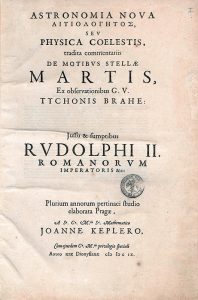By Paolo Rossi, theoretical physicist and science historian

For many centuries astronomy has been the science which most acquired and used huge amounts of data. A good example of the extraordinary results obtained with this practice is the discovery of Kepler’s laws of planetary motion, starting from the observations performed by the Danish Tyge Ottesen Brahe (1546-1601). Of noble birth, Brahe soon showed a strong interest in astronomy. However, both for the eclipse of 1560, and for the conjunction of Jupiter and Saturn of 1563, he noticed the lack of precision in the predictions based on the data available at this time. Therefore, he devoted himself to improving them substantially, realizing the large observatory of Uraniborg. The results collected in thirty years’ time allowed him to debunk the immutability of the celestial world, by demonstrating the supernova of 1572 and the comet of 1577 must have been very far from the Earth, since their position in the celestial sphere did not change during the day and so they were external to the sublunary world, unlike what argued by astronomers and philosophers. The precision of Tycho’s observations (the Latin name used by Brahe) exceeded of an order of magnitude all the previous results, reducing the error to one arcminute, which was the best you could get with the naked eye. Against the Copernican hypothesis of a moving Earth, Tycho tried to fit the data with his own prejudice formulating a model in which the Sun rotates around the Earth, but the planets rotate around the Sun. The model was quite popular for a long time, especially in those circles reluctant to accept the heliocentric theory. Anyway, a “revolutionary” element lay in the elimination of crystal “spheres”, inconsistent with the existence of orbits meant to intersect. The reputation of the Danish astronomer – who in the meantime had moved to Prague – got to the young German mathematician Johannes Kepler (1571-1630). The latter visited Brahe at the beginning of year 1600, but he was received in the observatory just in September, and by the way, he did not have access to all the data gathered by Brahe, and of which he was very jealous. Kepler had already devoted great attention to astronomy, with a decisive Copernican orientation, but in his first important work, the Mysterium Cosmographicum (1596), he had focused on exposing a model of the solar system in which the planets orbits were connected to Platonic solids and Tycho’s results served to support his own theory. He wrote to his master Michael Maestlin: “Tycho owns the most accurate observations in the world, but he’s missing an architect capable of constructing a building starting from his data”. Fortunately (for us), the limited task that Tycho assigned to Kepler was the study of Mars’ orbit in the framework of the semi-heliocentric model. Kepler bet that it would take him eight days to do it, but actually it took him many years. In any event, the collaboration wasn’t meant to last long, because Tycho died in October 1601. Acting unscrupulously – as he himself admitted – Kepler seized the data even before he was appointed Tycho’s successor as imperial astrologer. He could thus continue the work which had become the main purpose of his life: the construction of a mathematical model of Mars’ orbit describing accurately the observations. It is critical to underline that, in his search, Kepler was driven by the need – quite “modern” – to identify a dynamical mechanism that could justify the planetary motion’s law. Since he attributed the cause of the motion to a “force” originated by the Sun, his first fundamental progress was referring the planets positions to the Sun itself. Thanks to Tycho’s data, this allowed him to soon find out the “second law” stating that the line between the Sun and the planet “sweeps” equal areas in equal times. The inverse relationship between speed and distance – associated to a direct connection between force and speed – convinced him of the existence of a decreasing force as 1/r, against his original (and extraordinary) intuition of a decreasing force as 1/r2, whose subsequent demonstration would require the notion of centipede acceleration as well as Newton’s work. For five years Kepler explored any possibility that allowed to trace back Mars’ orbit to a circumference, as can be seen in his fundamental treatise Astronomia nova (1609). However, his best result – although very consistent with the observations – showed some deviations up to eight arcminutes, completely unacceptable in the light of data precision. Therefore, Kepler resigned to assume the orbit could have an ovoid shape, and tested various curves, stopping at the ellipse only when he realized in that case the Sun would have occupied exactly one of the focuses. The accuracy in that way of reproducing the data of Mars’ orbit pushed him to extend his “first law” to all the other planets. Tycho’s data were essential also to reach the “third law” relating the square of the planets orbital period to the cube of the semi-major axis of their orbit. This relationship didn’t satisfy Kepler, who – based on his hypothesis about the force – had been expected a relationship between the periods and the square of distances. But the facts were irrefutable. Willing to find an epistemological “moral” from the whole story, as well as a lesson for nowadays, we can say – as it often happened in the history of physics – data, even if accurate, wouldn’t have allowed to formulate a law sufficiently general and predictive. Data aren’t enough: most of the time you need a sound theoretical pre-judgement (mind the hyphen) to construct a scheme through which you can interpret the data. Without the idea of a force originating in the Sun, an idea that not even Galileo formulated or shared, Kepler might not have ever achieved a result that not less (maybe more) than the telescope “first cleared the paths of firmament”.
b. Frontispiece of the Astronomia Nova first edition.
Translation by Camilla Paola Maglione, Communications Office INFN-LNF
 INFN-LNF Laboratori Nazionali di Frascati
INFN-LNF Laboratori Nazionali di Frascati
